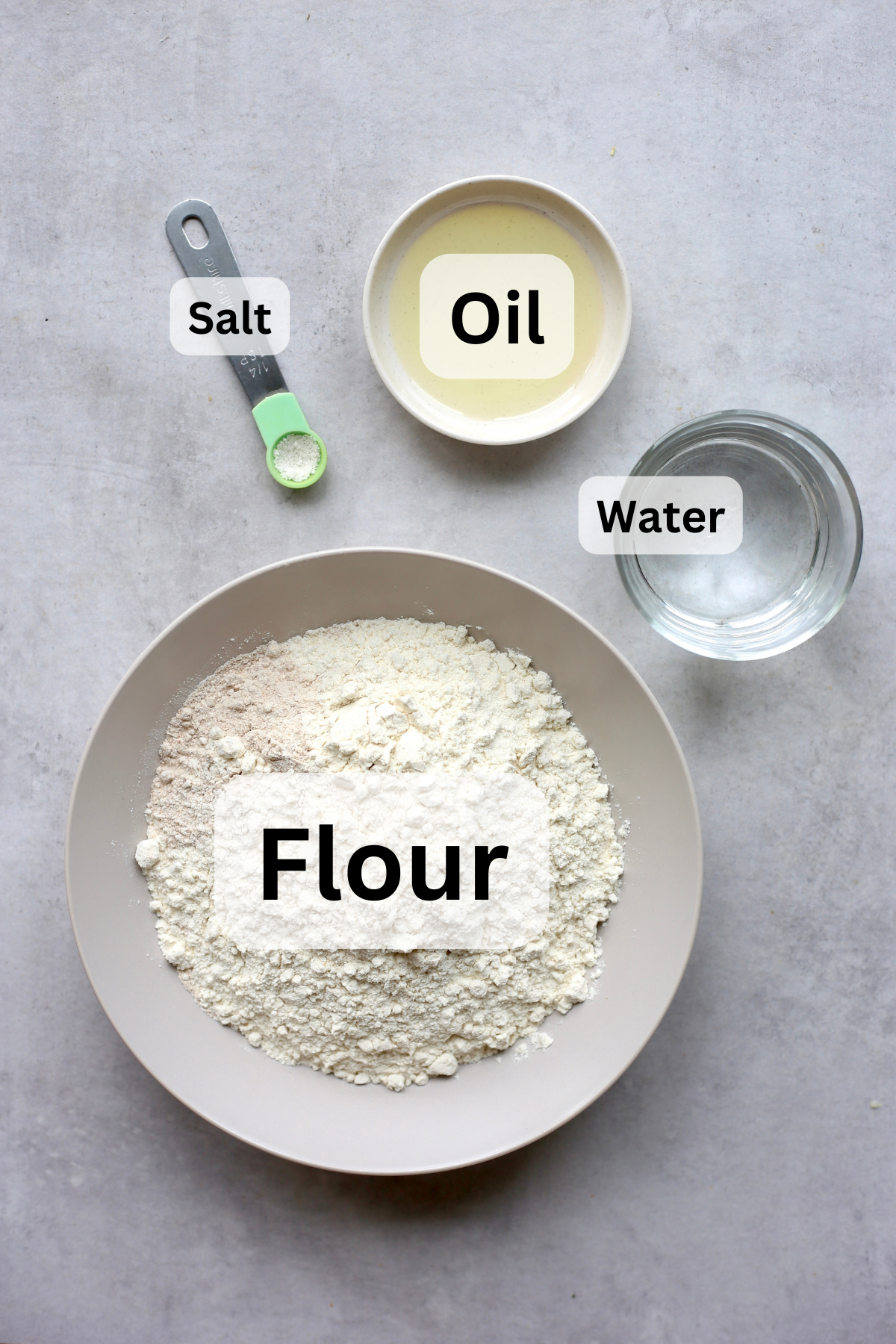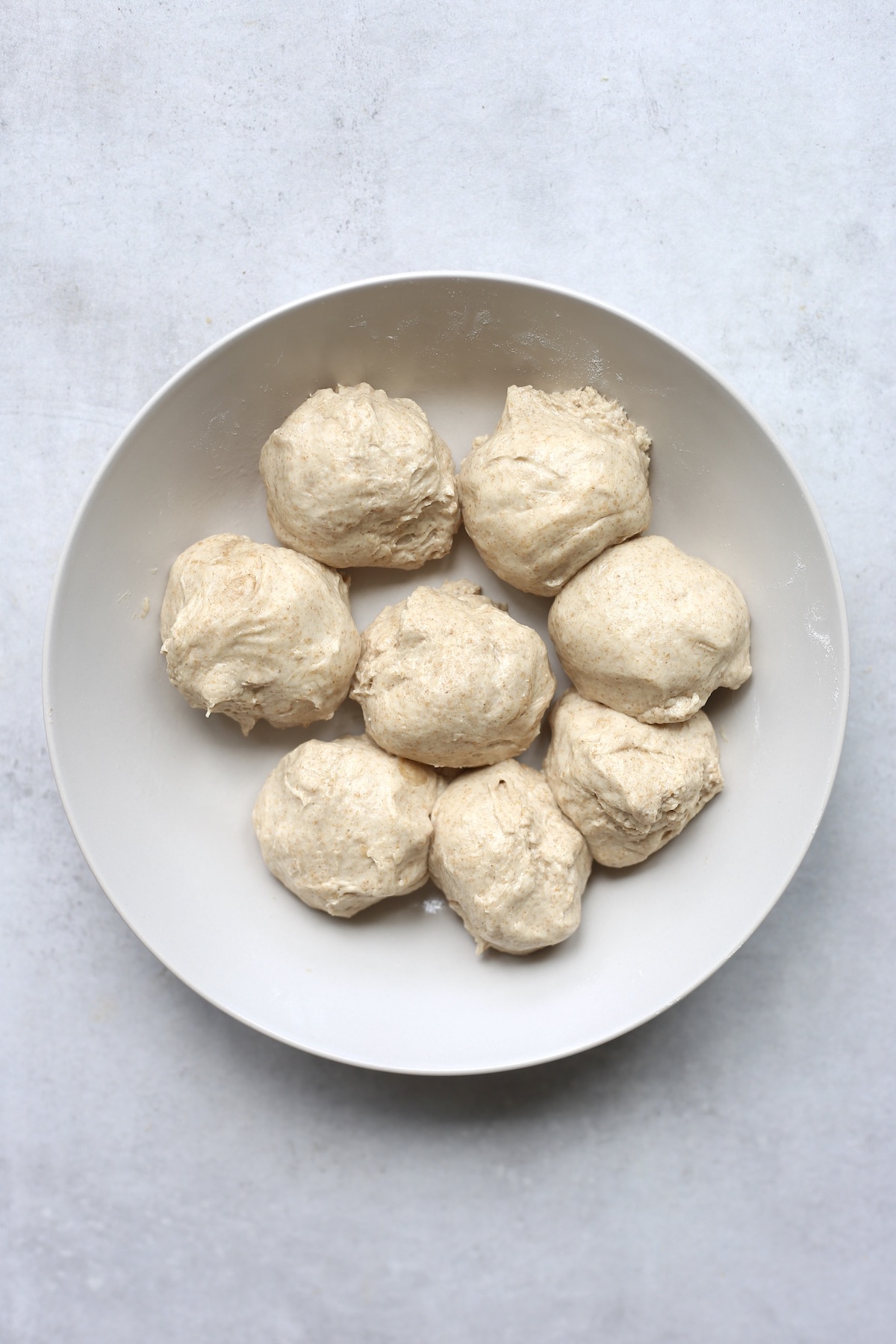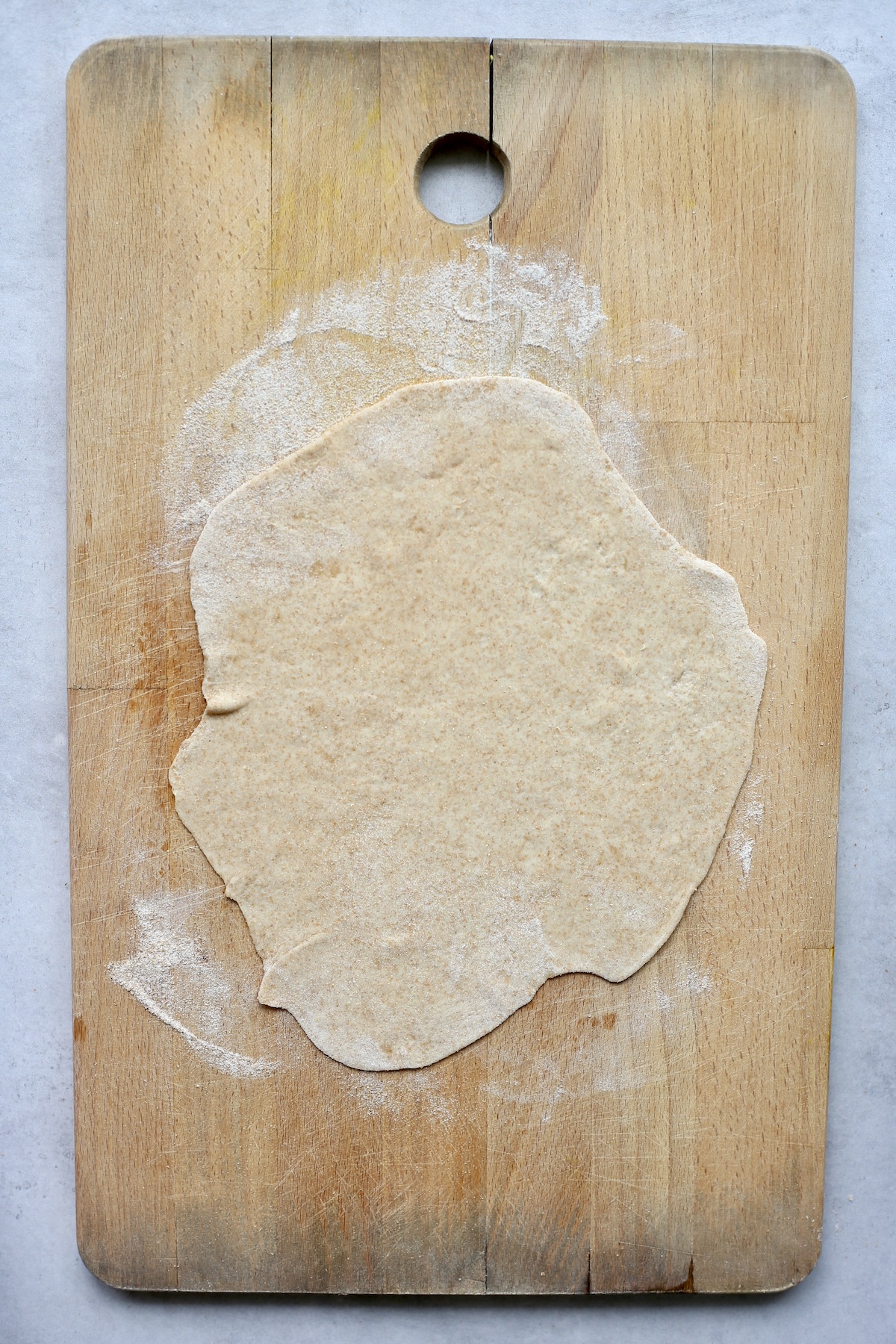This authentic chapati recipe (चपाती) includes step-by-step instructions with pictures of each step so that you can make your very own chapati at home! Chapati, also known as Indian Flatbread, is perfect for dipping or stuffing with your favorite Indian fillings!

There is nothing better than homemade bread and every country and culture seems to have their own version, all of which are amazing. Since we eat a lot of curries for dinner, including this easy chickpea tikka masala and this creamy peanut butter curry, I love to make Homemade Indian Flatbread to pair with it! This chapati recipe is perfect for beginners as it only requires 4 ingredients and I've provided step-by-step instructions to help you out every step of the way.
Jump To
Why You'll Love This Recipe!
- This recipe basically requires just 3 ingredients, all of which you probably have on hand. It can't get much simpler than that!
- While this chapati recipe takes a few steps to make, every step is super simple and easy to follow.
- Indian flatbread seems to pair well with so many different recipes and flavors. I love to make a double batch at the start of the week to use as wraps or to pair with curry and/or soup throughout the week.
- You'll feel like an Indian chef making your own chapati at home!
Ingredients

- Flour - You'll need 2 cups of flour total. I like to use a mix of white and whole wheat.
- Water - I usually add a splash of hot water to room temperature water to get warm water.
- Oil - I will warn you that in order to make authentic chapati you can't have a phobia of oil. You'll be brushing oil on these bad boys a number of different times...and it's gonna be delicious! I recommend using a neutral flavored oil such as vegetable or canola oil.
See recipe card below for a full list of ingredients and measurements.
Substitutions & Variations
- Flour - I like to use half white and half whole wheat flour, but you can use all white or all whole wheat as well. If you use all whole wheat flour, you'll probably need more water to get the dough to form.
- Oil- If you want to lighten up this recipe you can skip steps 4-7 and use more cooking spray, but just know that the chapati won't turn out as soft and pliable.
- Flavors - You can add more flavor to these Indian flatbreads by adding in some dried or fresh herbs, minced garlic or onion to the dough. Get creative!
How to Make Chapati

Step 1: In a large bowl, whisk together the flour and salt. Pour in the water and stir until dough forms.

Step 3: Cover the dough with a towel and let it rest in a warm spot for 30 minutes to 2 hours.

Step 2: Poke holes in the dough with your fingers and pour a little oil in the holes.

Step 4: After the dough has sat for an hour or so, knead it for a minute or two in the bowl to incorporate the oil into the dough.

Step 5: Divide the dough into 8 equal pieces.

Step 6: Take a section of dough and roll it out on a lightly floured surface. You will probably have to flip it over a few times. Make sure it doesn't get stuck to your rolling surface.

Step 7: After you've rolled the dough into a thin, large circle, cut a slit in the dough from the center to the edge. Using a pastry brush, brush a little oil all over the surface of the dough.

Step 8: Then using your hands, start from one edge of the slit and roll the dough up into a cone. Take the last corner of the dough and push it into the center of the cone to seal the dough.

Step 9: Repeat steps 6-8 for the remaining sections of dough until you have 8 little "flowers". Place the "flowers" on parchment paper and try not to let them touch or they may stick together. Cover the dough with a towel and let them rest for another 30 minutes.

Step 10: Preheat a large skillet to medium heat. Roll out the dough one section at a time on a lightly floured surface. Spray your heated skillet with cooking spray. Place the rolled out dough onto the skillet and turn it a little with your hand so that it doesn't stick. Quickly brush the top surface of the dough with oil.

Step 11: Flip the dough over and brush the top surface of the dough again with oil. Soon bubbles will begin to form in the dough. Let the dough cook for about 30 seconds while you use a fork to move it around and keep it from sticking.

Step 12: Repeat steps 10 and 11 until all the sections have been rolled out, cooked and are stacked on top of each other. Covered the chapati with aluminum foil and a dish towel to keep them warm and pliable.

Top Tips
- Don't be scared of oil! Adding a thin layer of oil at different stages in the process makes these Indian flatbreads super soft and pliable.
- Once you finish cooking a chapati, place it on a large piece of aluminum foil and fold the foil over the chapati. Then place a dish towel overtop. Keeping the chapati covered will help them to stay soft and pliable.
Recipe FAQs
The word chapat (चपत) in Hindi means "flat" or "slap". Flat comes from the bread's flat shape and slap from how it was made originally. Authentic chapati was traditionally made by taking wet hands and rotating the bread with each slap. Chapati is a staple food throughout South Asia, East Africa, and the many places around the world that north Indians have travelled and brought their culinary traditions.
To reheat leftover homemade Indian chapati, you can wrap the bread tightly in aluminum foil and place them in an oven preheated to 200°F / 90°C until warm.
This easy Indian Chapati Recipe pairs so well with a number of dishes! Basically anything you like to eat with flatbread would taste amazing alongside a piece of homemade Chapati. Some of my favorite dishes to pair with chapati are chickpea Chickpea Tikka Masala, Creamy Sweet Potato Peanut Butter Curry, Chipotle Roasted Cauliflower, and my Easy Baked Falafel.
What to Pair with Indian Flatbread!
Love this recipe? Please leave a 5-star 🌟🌟🌟🌟🌟 rating in the recipe card below & a review in the comments section further down the page.
📖 Recipe

Chapati: Traditional Indian Flatbread
Ingredients
- 2 cups flour all-purpose, whole wheat or a mix
- Pinch of salt
- 1 cup warm water
- Oil non-flavored oil is best
Instructions
- In a large bowl, whisk together the flour and salt. Pour in the water and stir until dough forms.
- Poke holes in the dough and pour a little oil in the holes. Cover the dough with a towel and let it rest in a warm spot for 30 minutes to 2 hours.
- After the dough has sat for an hour or so, knead it for a minute or two in the bowl to incorporate the oil into the dough.
- Then divide the dough into 8 equal sections.
- Take a section of dough and roll it out on a lightly floured surface. You will probably have to flip it over a few times. Make sure it doesn't get stuck to your rolling surface.
- After you've rolled the dough into a thin, large circle, cut a slit in the dough from the center to the edge. Using a pastry brush, brush a little oil all over the surface of the dough.
- Then using your hands, start from one edge of the slit and roll the dough up into a cone. Take the last corner of the dough and push it into the center of the cone to seal the dough.
- Repeat steps 5-7 for the remaining sections of dough until you have 8 little "flowers".
- Place the "flowers" on parchment paper and try not to let them touch or they may stick together. Cover the dough with a towel and let them rest for another 30 minutes.
- Prepare to cook the Chapati. Start by preparing your cooking station. Preheat a large skillet to medium heat. Have a small bowl of oil and a pastry brush nearby as well as cooking spray and a plate with aluminum foil and a towel.
- Roll out the dough one section at a time on a lightly floured surface. Again, be sure to flip the dough over as you roll it out so that it doesn't stick to your rolling surface. Add more flour if necessary. Roll the dough as thinly as possible.
- Spray your heated skillet with cooking spray. Place the rolled out dough onto the skillet and turn it a little with your hand so that it doesn't stick. Quickly brush the top surface of the dough with oil.
- After you've brushed the top surface, flip the dough over and brush the top surface of the dough again with oil. Soon bubbles will begin to form in the dough. Let the dough cook for about 30 seconds while you use a fork to move it around and keep it from sticking. After about 30 seconds, or once you see some brown spots on the underneath part, flip the chapati over and let the other side cook for a while until brown spots form.
- Remove, stack and cover. After you have cooked both sides, carefully take the chapati off the pan (I use a fork) and place it on your prepared plate with aluminum foil. Fold more aluminum foil over top of the Chapati and cover it with a dish towel. This keeps the Chapati warm and allows the oil to continue moistening the Chapati.
- Repeat steps 12-14 until all the sections have been rolled out, cooked and are stacked on top of each other and covered with the aluminum foil and a dish towel.
- Enjoy! Serve the Chapati warm or let them cool and store them in a zip-lock bag in the fridge for 4-5 days.
Notes
- I don't recommend trying to decrease the amount of oil in this recipe. Adding oil at different steps of this process is what makes chapati, well, chapati! The oil keeps the bread soft and pliable.
- To reheat these flatbreads you can wrap them tightly in aluminum foil and place them in an oven preheated to 200 degrees until warm through.









David Duncan says
I made these chapatis as I feel nan breads are too doughy I love chapati and your recipe is the best one I've ever tasted thank you very much and I just had a fantastic rogan josh with 2 and a half chapatis absolutely gorgeous thanks again
Faith VanderMolen says
So happy to hear you loved this recipe! Thanks so much for sharing David!
Aarthi says
I made the chapatis using Aashirvaad Whole Wheat Atta and the chapatis were so soft and tasty. Loved it.
Faith VanderMolen says
I'm so glad to hear that! Thanks so much for sharing!
Jenny says
Thanks for Sharing this even i want to learn to make perfect chapati..
Get full information of Restaurants in Delhi
Faith says
You're welcome Jenny! I hope you can try this recipe soon!